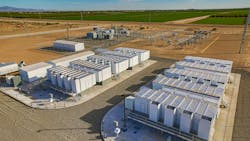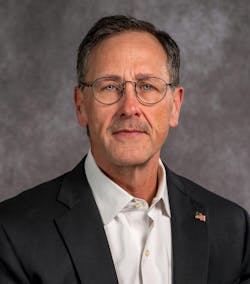Three Pillars Supporting the Microgrid Expansion: Q&A with PowerSecure President Jim Smith
Lest anyone doubt the commitment of many utilities to explore and deploy microgrids as keys to their resiliency and sustainability value chain, PowerSecure is one of the companies which offers a clear reply in the affirmative. Some utilities, at least, are all-in on the potential of microgrids within the energy transition future.
Atlanta-based utility holding company Southern Company acquired microgrid developer PowerSecure about eight years ago in a merger valued at close to $425 million. Southern Company owns numerous southeastern U.S. large-scale utilities including Georgia Power, Alabama Power, and Mississippi Power.
PowerSecure has focused on developing specific on-site power solutions for sectors such as data centers, government entities and manufacturing, among others.
Microgrid Knowledge Managing Editor Rod Walton queried PowerSecure’s President, Jim Smith, on his leading observations and inclinations about the current and future directions of microgrids and aggregated distributed energy resources on the many paths to net zero goals. His replies touched on everything from the historical role of microgrids as a resiliency and backup power option to growing challenges around resource adequacy and other opportunities for value creation from Microgrids. (PowerSecure is a platinum sponsor and among nearly 60 presenters involved at the upcoming Microgrid Knowledge Conference happening April 22-24 at the Marriott Waterfront Hotel in Baltimore).
Smith has worked as chief operating officer and president of energy efficiency services during his more than 10 years at the company.
Prior to PowerSecure, Smith’s career involved a broad array of duties in the energy sector for Lime Energy, Ameresco, Duke Solutions and Burlington Industries.
- - -
Rod Walton/Microgrid Knowledge (MGK): Jim, your career pretty much is steeped in clean energy project building, but you started in the textile and manufacturing side with Burlington Industries. Do you think that early experience outside of decarbonization helped you better understand where energy fits into the industrial sector and how to develop strategies to improve it?
Jim Smith (JS): Definitely. The experience gave me a front row seat to the challenges of both supply and demand issues. Several years later, common themes are still prevalent-- efficiency and resiliency are still cornerstone concerns and decarbonization is now layered on top. PowerSecure is creating holistic microgrid solutions customized to address supply and demand needs while benefiting the utility and end customer with the three pillars in mind.
MGK: PowerSecure also is leading a session at Microgrid Knowledge Conference in two weeks on “Navigational Channels and Challenges: Utilities and Microgrids.” How does the makeup of this panel tell us something new about the microgrid sector?
Jim Smith: Distributed energy resource strategies are being implemented across various utility sectors in the U.S., including investor-owned utilities, rural electric cooperatives, and municipally owned entities. While there are not one-size-fits-all solutions, underlying challenges are common. Microgrids, whether they are behind-the-meter (BTM) or front of the meter (FOM), offer interconnected solutions to most of the challenges. This panel will underscore the significance of addressing challenges with forward-looking solutions.
MGK: Your company has done microgrids in the utility sector, data centers, at military installations, airports, medical care centers, agriculture and across the retail space, right? Given this wide-ranging use case knowledge, are there particular sectors which are more poised for microgrid expansion than others?
Jim Smith: Microgrid installations are growing in areas where natural disasters present a resiliency and reliability concern first and foremost. We are all more dependent every day on the electric supply. Combine this need with the economic value of microgrid capacity to the grid and an affordable solution emerges.
Key drivers include geographic location, grid congestion, capacity shortfall associated with central plant retirements and new large load customers. We do think the expansion is accelerating and is driven by the utility capacity needs. Utilities can establish programs, policies and a roadmap that increases adoption for large swaths of customers.
MGK: What do you see as a potentially limiting the scaling up of microgrids and aggregated distributed energy resource projects?
Jim Smith: In our industry, interconnection agreement queues are growing, prolonging the time needed to install our solutions. We are also seeing lengthy delays in some local jurisdictions for local zoning and permitting. Connectivity to distributed energy resources for the purposes of dispatching those assets for the greater grid’s needs is not as simple as it seems.
MGK: The value chain for microgrids seems to be somewhere in the intersection of sustainability goals and mission critical reliability needs. Are those issues becoming more pressing and are events such as weather or grid adequacy helping make the case going forward?
Jim Smith: Most of our customers initially engage because of resiliency and reliability needs. As we engage with those companies, we offer options to address both their resiliency needs and other energy objectives. It is commonly discussed that there are grid challenges being driven by fossil fuel plant shutdowns, coupled with unprecedented data center growth through AI, EV charging and electrification. We collaborate with utility companies to help resolve these issues while making sure we align with long-term objectives. Throughout my career, I have witnessed fluctuating grid congestion and capacity needs.
MGK: So much of business is relationship building and being unfazed by surprises good or bad. Looking back on all the projects you’ve experienced in microgrids and decarbonization, is there anything that really adjusted your thinking about the energy transition and the people who are trying to make it happen?
Jim Smith: We treasure our deep utility and direct customer relationship and the opportunity to partner the two. In addition, increased venture capital funding and private equity funding are now driving new technology and business model entrants in this space, prioritizing speed to market. However, some of these new solutions lack a comprehensive understanding of their impact on the greater grid. Our solutions remain a valuable asset for solving customer problems. Our mission is to provide resilient and cost-effective electric power to everyone when the grid is not. We pride ourselves on being good partners to utility companies nationwide. We find that fostering these relationships significantly benefits utility customers.
MGK: Beyond microgrids, is there an area of aggregated DERs that you feel has an intriguing growth potential and why?
Jim Smith: Aggregations of distributed energy offer multiple benefits. During times of localized grid outages caused by severe storms, an aggregated network of distributed energy resources can be dispatched to aid in storm restoration efforts. An aggregation of distributed energy resources is useful to solve for short-term capacity needs on a localized basis. There’s significant growth potential in aggregating resources by area/zone, type of distributed energy resource, by fuel type, with AI playing an increasingly important role in optimizing usage. PowerSecure has invested in this capability to meet the growing demand with our 24/7/365 PowerControl center. This gives us a real time window into the 2600 sites and 2+GWs of assets that are under our control for aggregation.
MGK: Finally, this Q&A has been all work and no play. So, to wrap up, what do you do for fun and games?
Jim Smith: I enjoy the outdoors and vacationing with the family, scuba diving in exotic places. I never imagined the beauty and serenity that exist in our oceans. Over the past few years my latest hobby is shooting sporting clays competitively - what a rush! After a round of clays there’s nothing like a great cigar, a touch of whiskey and camaraderie.









